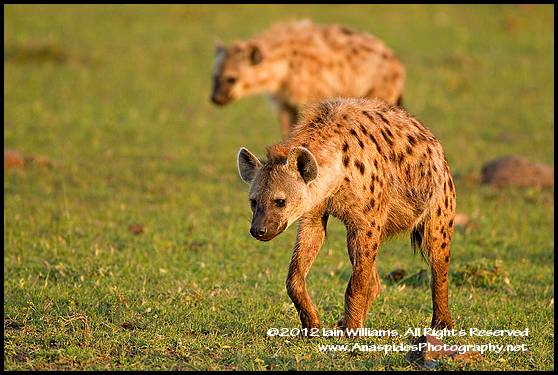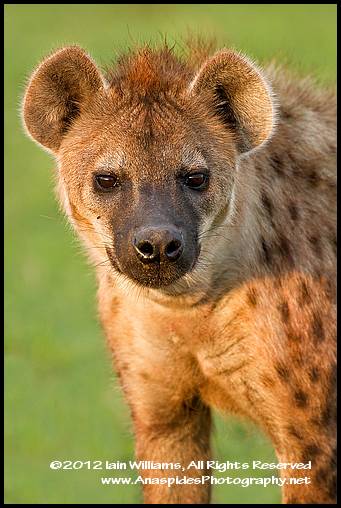Spotted Hyenas, Social Behaviour - Kenya, East Africa
 Tuesday, February 21, 2012 at 12:45PM
Tuesday, February 21, 2012 at 12:45PM  Following through from my last post, we established that hyenas belong to an ancient lineage called carnivora, are social animals, and live in a pack-like structure called a clan which, depending upon geography and food supply, can consist of up to 80 individuals. Although hyena behaviour is similar to that of wolves, hyena clans are much more compact and unified than in a wolf pack.
Following through from my last post, we established that hyenas belong to an ancient lineage called carnivora, are social animals, and live in a pack-like structure called a clan which, depending upon geography and food supply, can consist of up to 80 individuals. Although hyena behaviour is similar to that of wolves, hyena clans are much more compact and unified than in a wolf pack.
Hyenas use established dens, usually the diggings abandoned by another animal and enlarged for their purpose; often these dens are be used year after year.
LEFT: Two spotted hyenas, tired from the group chase and kill of a young wildebeest, trot towards the carcass to join the que to eat their breakfast (next image).
Complex Social Behaviour
Spotted hyena societies are more complex than those of other carnivorous mammals, and are remarkably similar to those of some primates in respect to group size, structure, competition and cooperation. Like primates, spotted hyenas use multiple sensory modalities, recognize individual conspecifics, are conscious that some clan-mates may be more reliable than others, recognize 3rd party kin and rank relationships among clan-mates, and adaptively use this knowledge during social decision making. Also, like primates, dominance ranks in hyena societies are not correlated with size or aggression, but with ally networks. In this latter trait, the spotted hyena further show parallels with primates by acquiring rank through coalitions. However, rank reversals and overthrows in spotted hyena clans are very rare.
 Females Dominate Males
Females Dominate Males
Females dominate males, with even the lowest ranking females being dominant over the highest ranking males. It is typical for females to remain with their natal clan, thus large clans usually contain several matrilines (alpha females) whereas males typically disperse from their natal clan at the age of 2½ years. The clan is a fission-fusion society, in which clan-members do not often remain together, but may forage alone or in small groups.
LEFT: The social structure of the clan is clearly visible in this photograph; two hyenas wait their turn to eat as the dominant female eats her fill.
High-ranking hyenas maintain their position through aggression directed against lower-ranking clan-members. Spotted hyena hierarchy is neopotistic; meaning the offspring of dominant females automatically outrank adult females subordinate to their mother. However, rank in spotted hyena cubs is greatly dependent on the presence of the mother; low-ranking adults may act aggressively toward higher-ranking cubs when the mother is absent.
Although individual spotted hyenas only care for their own young, and males take no part in raising their young, cubs are able to identify relatives as distantly related as great-aunts. Also, males associate more closely with their own daughters rather than unrelated cubs, and the latter favour their fathers by acting less aggressively toward them.
 Licking – A cross between a cat and dog
Licking – A cross between a cat and dog
Hyenas groom themselves often like members of the cat family, and their way of licking their genitals is very cat-like (sitting on the lower back, legs spread with one leg pointing vertically upward). However, unlike other felines, they do not "wash" their faces. They defecate in the same manner as other Carnivora, though they never raise their legs as canids do when urinating, as urination serves no territorial function for them. Instead, hyenas mark their territories using their anal glands, a trait found also in other members of the carnivora, but not canines and felines.
Vocalization
The spotted hyena is very vocal, producing a number of different sounds consisting of whoops, grunts, groans, chattering, lows, giggles, yells, growls, laughs and whines. During the mating period and when young cubs are around the den, the vocalization can often reach crescendo level. At night, it’s quite common to hear hyenas chattering and yelping as they go about their nocturnal business.
I spent considerable time with the hyenas and never tired of their company. Observing their individual antics, behaviour, hunting and hierarchy was fascinating.
Later, I'll unravel some of the mystic associated with hyena mating and we'll take a closer look at some hyena babies within the den. Then we will say goodbye to the hyenas and spend sometime with the highly endangered black rhinoceros.
REFERENCES: Wozencraft, W. Christopher (16 November 2005). "Order Carnivora (pp. 532-628)"



Reader Comments (1)
Great shots! Totally reminds me that I'm an amatuer. :-)